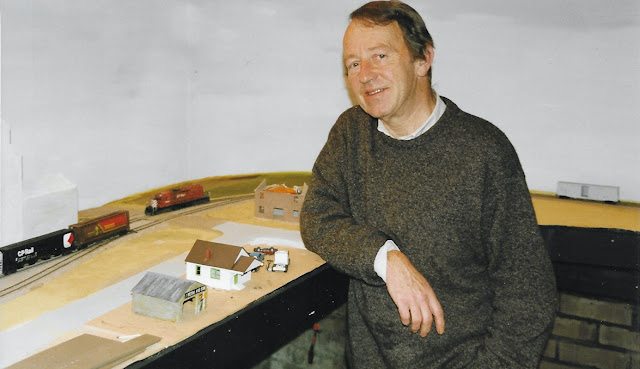Childhood Models: My Dad’s Shay…
"Nostalgia - a wistful desire to return in thought or in fact to a former time in one's life, to one's home or homeland, or to one's family and friends; a sentimental yearning for the happiness of a former place or time" (Dictionary.com)...
As a young boy there were several models in my Dad's 'collection' that held an almost mythical status - over the years these were seldom seen. I recall asking Dad if we could run them, occasionally he would indulge me and bring them out to the train room. The Hornby Class 58, the Mainline Class 03... and possibly the greatest of them all, the Roundhouse Shay!
 |
| Shay, logging skeleton car (I've a few of these but they all need work) and a Roundhouse combine, all built and painted by my Dad, Keith Hilton. Posed on Kinross. |
I learnt from Dad through these brief encounters that this model had been a real labour of love for him. He was a master at 'stage carpentry' (master bodging) and scenery, I do sometimes still wish I could bounce a scenic ideas off him, or get his help or tutoring - however, locomotives and rolling stock were nothing more than actors on the stage - I know of only a handful of kits he every built - mostly rolling stock (and three of them in this photo) but the Shay was the only locomotive - from that, and from his description of the difficult birth it suffered I always had the impression it was a bit of a dog, it certainly wasn't a great running model, noisy and listing dangerously when running, but as a young boy seeing the working side mounted cylinders and drive train and realising 'my Dad' had built that, it was inspiring.
 |
| Dad, circa 1997 before, a good ten years before his health deteriorated, with his magnus opus, 'Harris' in the garage. |
So why did Dad build it? We didn't discuss logging railroads in great depth, but I picked up through snippets of conversation or magazine articles that he had a real interest in their development and how they opened up the Canadian rockies in the west - as a geographer this kind of social history was a passion of his - later in life teaching about the settlement of Canada by Europeans and it's impact on the native populations whilst Head of Geography at the University of Chester - I infer the combination of the physical landscape, the social geography and the wonder of the crazy logging railroads and locomotives themselves drove the building of that model.
 |
| Dad, at Caernarfon 2005. Another 'engine that bends', the NGG16 was a fascination for us both. |
I'm lucky the Shay is in my collection - I am proud of it - and I've gently tinkered with it over the past 10 years. Initially it wasn't a runner, so cleaning up, gently lubing things and checking the drivetrain I coaxed it back into life. The sound, the smell of that massive old fashioned open frame motor - it took me back in an instant to peering over the edge of the childhood layout to watch the drive train move - poetry in motion to my young now old eyes.
More recently, with thoughts of developing my own logging project, it has come back into my consciousness and having adjusted and packed the gearbox with silicon the running is massively improved, as shown in the video. I could leave it like this, of just my Dad's hand - but time has passed, and now it feels more fitting for the model to become part of my working collection - perhaps touching up and refining some of the detail, painting and weathering, whilst keeping his livery and basic paintwork intact. I'd love to use it alongside the Hilton-Mears Fairbanks Morse in time, I have a strong suspicion that Kinross will be stored in the spring and a new layout built to take the same space. In the meantime, I hope you've enjoyed reading a little about the model, seeing it run, and perhaps reflecting on your own connections, your own ribbons with the hobby. Until next time, more soon...

Lovely post. I used to make forays to Victors in London to buy MDC Roundhouse kits along with Narrow Gauge & Shortline Gazette. I was always put off their locos by the number of articles that covered how to completely rebuild the mechanical parts of them.
ReplyDeleteThank you James, that’s very kind. I’m 99% certain this came from Victor’s too… we lived in London until I was 4, Dad was working in the School of Education as a lecturer in Geography - he also wrote a couple of A-level Geography text books at this time too… funny what you remember when people mention things… anyway he used to pop to Victors quite often. Even when we moved to Chester his trips to London for the Remote Sensing Society often netted a trip to Victors and a new Athearn or Roundhouse boxcar kit.
DeleteVisiting Victors, this would be around 1986, you felt there was a mix of a resident social club and those making frequent pilgrimages. I was introduced to it by an ex-Chief Petty Officer who worked for me, graciously since he was some 45 years older than me. Afterwards we would eat in a little Italian Cafe that did the most sublime bacon, liver, and onions. It is one of many London model shops I mourn
DeleteI’m sure I remember my Dad mentioning an Italian cafe! Yes, he would have been more of an infrequent visitor, I’m sure, and pilgrimage sounds about right, I’m sure it was a the ride and bus journey from the location of many of his meetings. I never visited, Dad promised we’d go, but the one time I accompanied him we ran out of time… sadly.
Delete